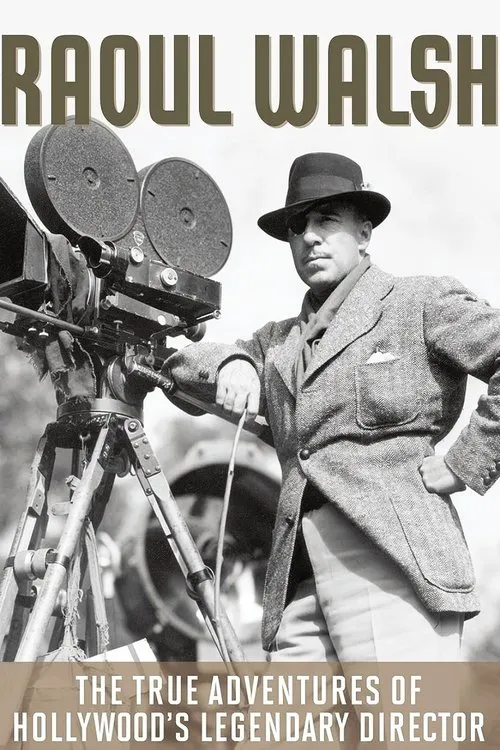The True Adventures of Raoul Walsh

Enredo
Raoul Walsh was born on November 17, 1887, in New York City to a family steeped in the theater. His father, William Henry 'Billy' Walsh, was a renowned actor, manager, and theater owner, and Raoul was raised in a world of make-believe, where the boundaries between life and drama blurred. This was an era when the nickelodeons, small, coin-operated film projectors, were springing up across the city, captivating the imagination of America with the magic of cinema. It was a time when the fledgling film industry was bursting forth with creative energy, attracting individuals from the world of theater and beyond to its rapidly expanding shores. Walsh's early life was marked by a series of formative experiences that laid the groundwork for his future as a master filmmaker. His family's involvement in theater life exposed him to the intricacies of the craft, while his travels across the United States and abroad fueled an insatiable curiosity about the human experience. He began working as an actor, eventually finding his way to the Biograph Compan, where he was apprenticed to the influential D.W. Griffith, a pioneering film director known for his groundbreaking works, such as "The Birth of a Nation" (1915) and "Intolerance" (1916). Working under Griffith, Walsh witnessed firsthand the emergence of American cinema as a force to be reckoned with. He learned the art of montage, experimenting with camera techniques, editing, and storytelling, all skills that would later become hallmarks of his own filmmaking style. As Walsh delved deeper into the world of cinema, he became increasingly drawn to the world of action and drama, where the boundaries between reality and fiction became increasingly blurred. The advent of World War I marked a turning point in Walsh's life, both personally and professionally. Enlisting in the United States Marine Corps, he soon found himself at the front lines of some of the most brutal battles of the conflict. Witnessing the horrors of war firsthand, Walsh was changed by the experience, returning to America as a man forever altered by the traumas he had endured. This period also marked the beginning of his work behind the camera, as Walsh began to transition from acting to directing, bringing a newfound sense of grittiness and realism to his work. Upon his return to Hollywood, Walsh quickly established himself as a respected director, helming a string of successful films that catapulted him to prominence. His first major breakthrough came with the 1917 film "The Wanderer", which introduced audiences to his distinctive flair for the dramatic. This was followed by "The Silent Lie" and "Regeneration", both of which cemented his reputation as a master of cinematic storytelling. Throughout the 1910s and 1920s, Walsh continued to push the boundaries of his craft, experimenting with innovative techniques, such as the use of location shooting and non-linear narrative structures. One of his most notable achievements during this period was "The Thief of Bagdad" (1926), an epic fantasy film widely regarded as one of the greatest cinema treasures of all time. Starring Douglas Fairbanks, the film's groundbreaking use of special effects, elaborate sets, and breathtaking action sequences redefined the possibilities of cinematic storytelling. As Hollywood entered the 1930s, Walsh's career continued to soar, as he directed a string of classic films that showcased his exceptional range. "The Big Trail" (1930) was one of his earliest forays into the emerging art of widescreen cinematography. Starring John Wayne in one of his early starring roles, the film's pioneering use of CinemaScope technology set a new standard for action-adventure films. This was followed by "Baby Face" (1933) and "Dancing Lady" (1933), both of which showcased Walsh's ability to craft compelling dramas that explored the intricacies of the human condition. The 1940s and 1950s were arguably some of the most productive years of Walsh's life, as he continued to push the boundaries of his craft, experimenting with new techniques, styles, and genres. He was particularly drawn to the world of comedies, helming classics like "Sailor Beware" (1933) and "Man of Conquest" (1954). The latter, a sweeping historical epic starring Richard Widmark and Virginia Mayo, demonstrated Walsh's unique ability to blend action, drama, and comedy, creating a cinematic experience that captivated audiences worldwide. Throughout his career, Walsh was known for his unwavering dedication to the art of filmmaking, always pushing himself to new heights and exploring the very limits of his craft. He was a master storyteller, able to weave complex narratives that captivated audiences and inspired his actors. His collaborations with some of Hollywood's greatest stars, including Humphrey Bogart, James Cagney, and Errol Flynn, resulted in a body of work that continues to captivate audiences today. As the tumultuous 1960s came to a close, Walsh looked back on a remarkable career spanning over seven decades. With an estimated 145 films to his name, he had left an indelible mark on Hollywood, leaving behind a legacy of cinematic magic that continues to inspire filmmakers to this day. Despite his passing on December 31, 1980, at the age of 93, Walsh's influence can still be felt across the cinematic landscape, reminding us of the power of storytelling and the transformative magic of the movies.
Resenhas
Recomendações



